Part 4. Conclusions: Is There Proof?
© Bruce G. Marcot
 This little
exercise does not "prove" that there is no Bigfoot or its cousins.
This little
exercise does not "prove" that there is no Bigfoot or its cousins.
It does remind me that tracks can be deceptive (I've surely puzzled over a number of carnivore tracks myself). And that at least some tracks honestly reported as from Bigfoot and friends may very well have been made by bears or other large animals in unusual patterns as I have demonstrated.
In science, we strive to use the simplest and, to paraphrase Occams' razor, the least bizarre explanations first. Only when they prove inadequate is it time to move on to more involved explanations. This is the tried and true scientific Principle of Parsimony.
I suggest that some of the tracks may be caused by known agents including bears or other large wildlife. However, I venture that this explanation does not cover all reported Bigfoot tracks.
As for evaluating the other evidence -- the reports of visual sightings and encounters, the tribal legends, the supposed nests and taped calls ... well, we have to leave something to do tomorrow, don't we? And I still hope that some evidence out there may one day reveal an evolutionary cousin we lost along the way...
- - - - - - - - - - -
Addenda
Two Scientifically Credible Papers on the Topic
Bodley, J. H. 1988. Sasquatch footprints: can
dermal ridges be faked? Northwest Science 62:129-130.
In this paper, published in a reputable scientific journal,
the author presents results of his findings that a plaster track cast of
a large unknown animal contained dermal ridges -- those lines that form
your fingerprints. How they got onto the cast, and what made them,
is unknown.
Glickman, J. 1998. Toward a resolution of the
bigfoot phenomenon. North American Science Institute, Hood
River, OR. 43 pp.
Want to see a masterful analysis of tracks and gaits,
and comparisons with known primates? This is it. It is also
a major photographic analysis of the Patterson film -- about as far as
such an analysis can be pushed scientifically, in my opinion. It
concludes that there is neither evidence supporting nor disproving the
Bigfoot phenomenon, including the Patterson film. Which is a nice
way of saying that we cannot rule out possibilities.
[2003 update: this past year, various news media
ran stories suggesting confessions by culprits in devising the Patterson
film. If this is true, then the analysis used in this report is still
a lesson in the scientific method: failing to falsify a hypothesis
does not mean that the hypothesis is "proven" true, only that there
is no evidence by which it is demonstrated to be false.]
On the Yetis of the Himalayas
I have just viewed a video showing a
snow
leopard striding in belly-deep snow in the Himalayas. The cat
was quite clearly walking in its own tracks, the hind foot stepping into,
and sometimes slightly just behind, the track made by the front foot.
The result was a set of elongated tracks that looks remarkably like a side-to-side
bipedal track.
Other Big Cats
Other big cats often overstep their own prints. I once tracked a mountain lion (Felis concolor) in the Klamath Mountains of northwestern California for several weeks. One set of tracks led into and up a muddy slope of a small pond that was drying up. I took plaster casts of several of the prints in the sequence. The casts clearly showed the claws extending for gripping the slippery slope, and that the hind feet were being placed directly in the tracks of the forefeet, overlapping the prints. Some of the casts I took clearly showed five toes in front of the pad, not four, because the cat was stepping in its own tracks.
Another large cat that sometimes may overstep its
own prints is tiger (Panthera tigris).
In Panna National Park
in central India thorn-scrub woodland, I photographed tracks of a Bengal
tiger (Panthera tigris tigris) that had walked through a muddy wash. The following photo
in this sequence clearly shows five toes, but tigers, like all cats, leave
imprints of only 4 toes per foot. Clearly, this cat had stepped directly
into its own print.
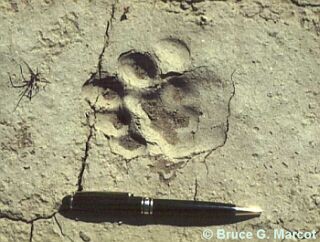
The rest of this tiger track sequence in the mud showed very similar tracks, as if there was a bipedal, five-toed tiger on the prowl! For example:
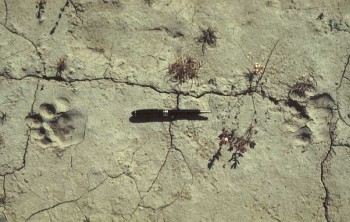
Later in the track series, however, the forefoot and hindfoot tracks diverged into their more usual gait.
Here are three more photos I took of the tracks of a large male Bengal tiger, this time on an island in the Brahmaputra River in Assam, northeast India, along Kaziranga National Park. Each of these photos also shows the typical pattern of overstepping tracks in a steep muddy bank; some had the "five-toed" appearance of this normally four-toed track:
There are stories from some of the native tribes of India of people being able to transform into animals, including tigers. One such story comes from the Garo Hills tribe of the state of Meghalaya in the northeast -- the same tribe with the story of Forest Man or Matdngdng I mentioned earlier. The Garos also believe in Matcha, a person whose essence or soul can at least temporarily inhabit tigers in the jungle. I wonder if such 5-toed tracks as shown in my photo above accounts for such myths?
Here is a photo of Siberian tiger (Panthera tigris
altaica) tracks I photographed
outside camp at a tiny settlement called Ulanga, of the Udege tribe, in the Upper Bikin
River Watershed of Primorski Krai, Russian Far East. This shows a
slightly overstepping pattern but each paw print remains clearly identifiable:
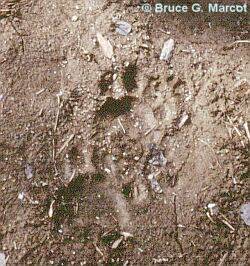
I had asked my Udege companions if there was a legend
in their culture similar to our Bigfoot, and they laughed and replied no,
and that "maybe Russians are more practical than Americans."
In northern India, in Corbett National Park, I sighted a large male fishing cat
(Prionailurus viverrinus) which left a set of tracks along a muddy river
bank, including several where it was overstepping its own prints (image and
colors enhanced here to show details):
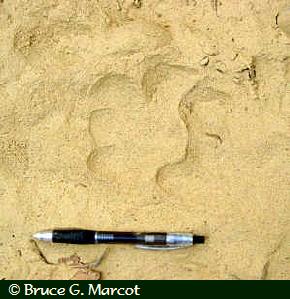
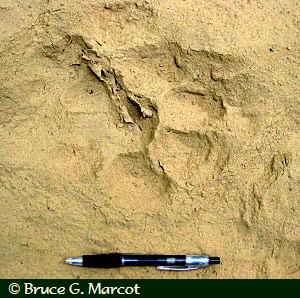
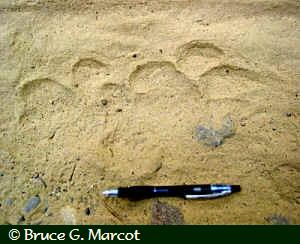
Other Overstepping Tracks
In this section I present photos I have taken of a wide variety of other mammal species that sometimes create overstepping tracks.
Bears and snow leopards are not the only large creatures that show the overstepping phenomenon. Many large animals do this, including the African elephant. I photographed the following image in Zimbabwe, southern Africa, where a large elephant had overstepped its own track, producing a monstrous-sized oval track not unlike the "Matdngdng" track mentioned earlier:
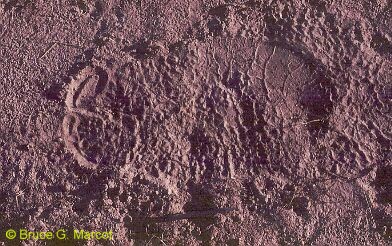
The following picture is of African elephants tracks showing a different overlapping pattern. I took this obliquely-angled photo with a telephoto lens from a bridge, along the dry river bed of the Luangwa River in South Luangwa National Park, eastern Zambia. These tracks are likely a larger adult overlapping two other elephants' tracks following the same stride and path, creating this odd, two-lobed track pattern.
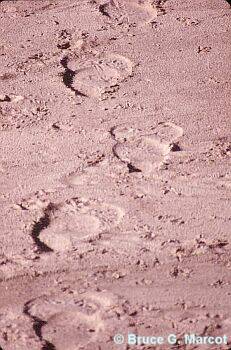
Also from Africa, the hippopotamus creates large tracks and sometimes oversteps its own tracks. Following is first a photo of a normal hippo track, and then a track overstepped by the same or a different animal, creating an unusually wide and strange-appearing print. I photographed these in Vwaza Marsh Wildlife Refuge along Lake Kazuni in northern Malawi, Africa.
Normal hippo track.
Overstepping hippo track.
Here is a photo of tapir tracks I photographed in Amazonian Bolivia showing that it too sometimes engages in this overstepping phenomenon:
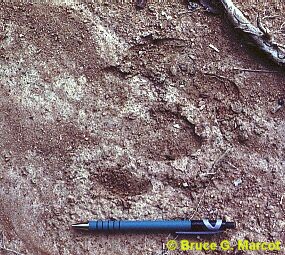
The track contours in the above photo may be a little difficult to distinguish if you don't know tapir tracks, but they do illustrate the overstepping phenomenon. For comparison, here is a photo, along the same track series, I took showing regular, non-overstepping tapir tracks:
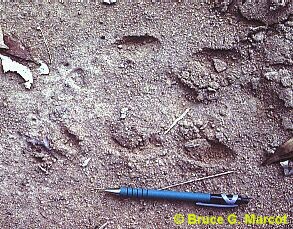
Here is a set of two overlapping tracks of banded mongoose (Mungos mungo) I photographed in Vwaza Marsh Wildlife Refuge, along Lake Kazuni in northern Malawi, Africa. Mongoose commonly overlap their tracks in this way.
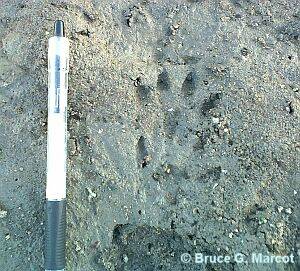
This is a set of overlapping tracks of vervet monkey (Cercopithecus aethiops) I photographed in South Luangwa National Park, Zambia, Africa. The hind foot track, on the right, partially overlaps the front foot on the left:
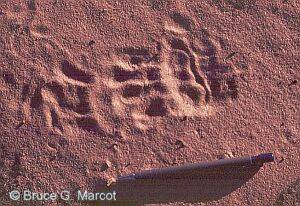
Primates in general tend to overstep their tracks (as do we). Here are overstepping prints of a Chacma or yellow baboon (Papio cyanocephalus) I photographed in Zambia:
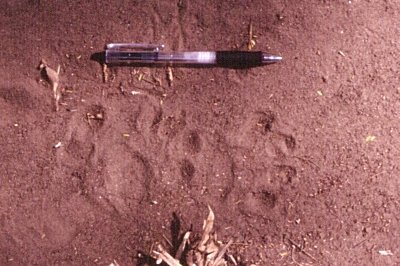
To round out this brief selection of overstepping primate
tracks, the next image here is of ancient hominid tracks initially excavated by
Mary Leakey and team in 1979 from Oldupai Gorge (often misspelled Olduvai)
in northern Tanzania. The photo below is of Leakey's team's mold of the
track sequence which they cast with silicone rubber and fiberglass resin to
preserve the sequence before it eroded away.
The signboard in the Oldupai Gorge museum describes this
track sequence as follows: "The G2/3 trail is two individuals walking
in tandem, the one stepping in the footprints of the others."
(Hominid Trackway at Laetoli, Site G, Oldupai Gorge,
Tanzania)
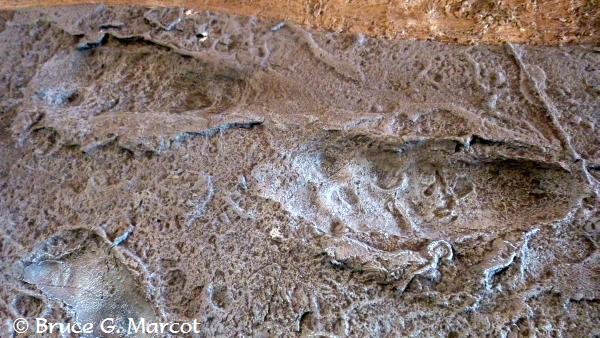
Next is a pair of tracks of spotted deer or chital (Axis axis) from northern India. Note how the track on the left is single and regular, but the one on the right shows this overstepping pattern and is elongated.
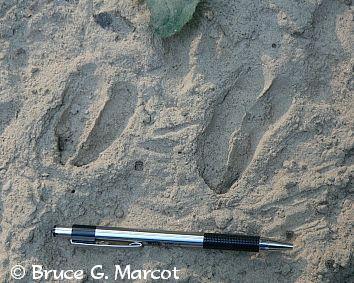
Here are
two sets of overstepping tracks in a track sequence of a black-tailed deer
(Odocoileus hemionus) in the central Cascade Mountains of Oregon,
USA. When stepping in mud or snow, many species do tend to overstep their
tracks to make traversing easier.
And here are some overstepping tracks of black-tailed deer in rain-soaked muddy soil, which I photographed in the Cascade Mountains of southern Washington, USA. These are slightly offset, making it easier to identify the individual tracks.
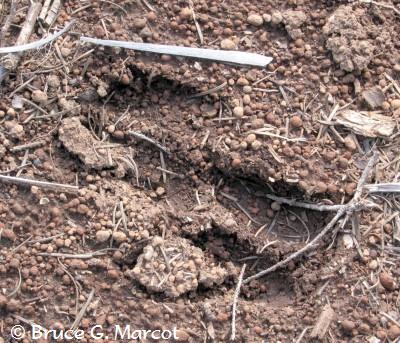
Next, here is a most interesting sequence of tracks from a moose
(Alces alces) I discovered one night outside my hotel window in snowy
Anchorage, Alaska. The dark spots on the snow are its pellets. (The
photo is a bit grainy and in grayscale because I took it at night.) Notice
especially how the moose was stepping in its own tracks, forming what
superficially looks like very large and widespread bipedal tracks all the way
down the track sequence.
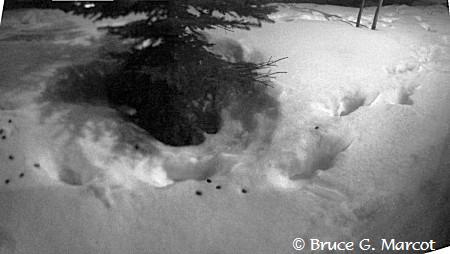
Click on the above photo for a larger version.
Next are tracks of a raccoon (Procyon lotor) from
the edge of a pond in the Klamath Mountains of northwestern California.
This is one example of several tracks in this sequence that show an overstepping
pattern. Count the number of toes on this track: six (maybe seven) ... and
notice the elongated foot pad impression ... both indicative of
overstepping.
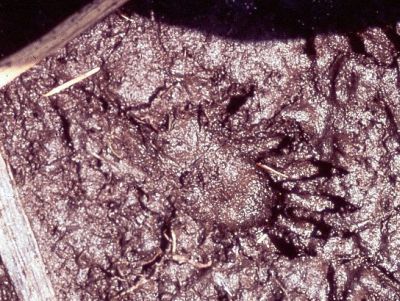
And here is yet another example, this time from a smaller mammal yet. I photographed the following snow tracks in the Cascade Mountains of Oregon, USA. It is a Douglas' squirrel (Tamiasciurus douglasii).
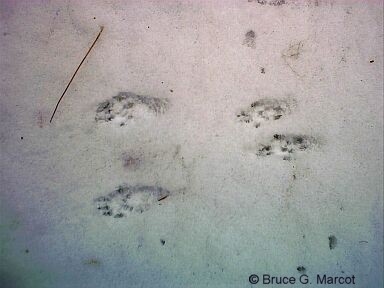
This squirrel was running from right to left. The two smaller prints on the right are its front feet, which it planted down in the snow first, then brought its hind legs around those and dug them in front (the larger prints on the left), then pushed off and sprang ahead. This is a typical style of locomotion for squirrels (and rabbits) and it produces this typical print pattern.
I followed it a ways through the snow and then encountered this next aberrant print:
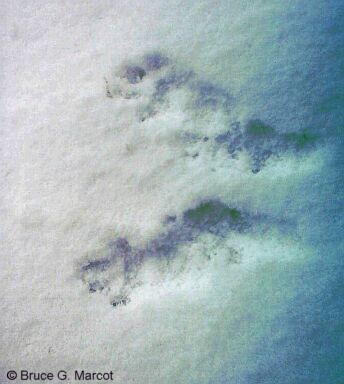
In this print, the squirrel likely had slowed down, still moving right to left here. The prints of its hind feet partially overlapped prints of its front feet, now appearing like only one set of huge, long feet. So, even small mammals sometimes do this overstepping pattern, and it was instructive to have seen this pattern in the same sequence of prints from the same animal.
Of course, I am not suggesting that all wildlife overstep their tracks, or that any overstepped track (especially those of squirrels!) would be called Bigfoot tracks. I am merely illustrating that the overstepping phenomenon occurs among a variety of large (and small) wildlife species.
[Note: Apparently, a few readers of my essay here, including J. Meldrum in his book, seem to ignore the above caveat, and presume that I am implying that all supposed bigfoot tracks are merely animals stepping in their own tracks. I am not saying this. I simply want to point out that I am merely cautioning against jumping to unwarranted conclusions when interpreting at least some tracks.]
What to Measure
Since I wrote this little treatise, especially the section dealing with what parameters of tracks to measure, in the library of the Wildlife Institute of India in Dehra Dun, Uttranchal, northern India, I encountered a paper by H.S. Panwar (1979), who has been one of the directors of Project Tiger in India, and a fellow wildlife biologist with whom I have worked in India. His paper provides a protocol for the kind of information to record from tiger tracks (pugmarks). Panwar recommended recording multiple tracks in a sequence, and specifically suggested caution when dealing with superimposed tracks.
He suggested drawing tracks on field tracing sheets (these days, digital camera pictures might replace a hand-traced image) and recording date, location, direction of movement, surface (soil type, texture, moisture level), freshness of mark, recording of any deformity, stride, sex, and recorder name. I have listed many of these same parameters, as well as measurements of track sizes, stride lengths, and other attributes.
Source: Panwar, H. S. 1979. A note on tiger census technique based on pugmark tracings. The Indian Forester, Special Issue on International Symposium on Tiger. Pp. 70-77. (no volume or issue numbers given)
Responses to This Web Site
I have received a number of responses to this Web
site, ranging in tone and temperament from unnecessarily caustic to highly
supportive. I have also been cited as saying or implying quite the
opposite of what I actually say; I would suggest that such authors re-read my
words here.
I especially greatly appreciate the open-minded
and gracious mail from Ray Crowe, Director of Western Bigfoot Society.
Mr. Crowe has been very supportive of trading information, and has kindly
sent me others' stories of Bigfoot and Yeti encounters. Thanks, Ray;
your good and generous spirit will go far to keep "mainstream" wildlife
science and cryptozoology close partners, as they should be!
More Thank-You's
I'm also grateful to my wildlife ecologist colleague
Mr. Ajai Saxena, of the Wildlife Institute of India, Dehra Dun, India,
who found the Nicholas Saunders book for me that I mentioned earlier, and
for also having a most inquisitive and open mind in discussing the subject.
Mr. Saxena is one of the few ecologists -- perhaps the only one! -- who
has climbed and hiked the arduous backcountry of the Garo Hills of Meghalaya,
India, home of the Matdngdng "Bigfoot cousin" in Garo Tribal legend, braving
armed insurgents, human-killing wild elephants, leeches, and other perils
we know nothing of in our safer western U.S. mountains. May Mr. Saxena's
courage and stamina be an inspiration for all field zoologists everywhere.
Many thanks, too, to Shri A.K. (Anup) Srivastava of the
Indian Forest Service in Meghalaya, India, who hosted me in his home in the Garo
Hills and allowed me to photograph his plaster cast of the Matdngdng
track.
I also appreciate a brief but very interesting chat
with Robert Michael Pyle, whose recent book Where Bigfoot Walks: Crossing
the Dark Divide is wonderful reading (Mariner Books, Houghton Mifflin
Co., 1995). This and his other superb volumes are recommended reading
to anyone with a soul and heart in nature. Thanks for the inscription
and inspiration, Bob.
Media Coverage
The ideas in this Web site have been picked up and reported by numerous other web sites and by several media, including the L.A. Times, the Contra Costa Times, and others. In media interviews, I have emphasized that I am only urging researchers to be cautious in their interpretations of footprint evidence, not that I have definitive proof of the non-existence of Bigfoot ... which, from scientific methodology, would not be possible. Unfortunately, some authors persist in wanting to characterize all wildlife biologists and scientists as "skeptics" and "disbelievers," and that is truly sad.